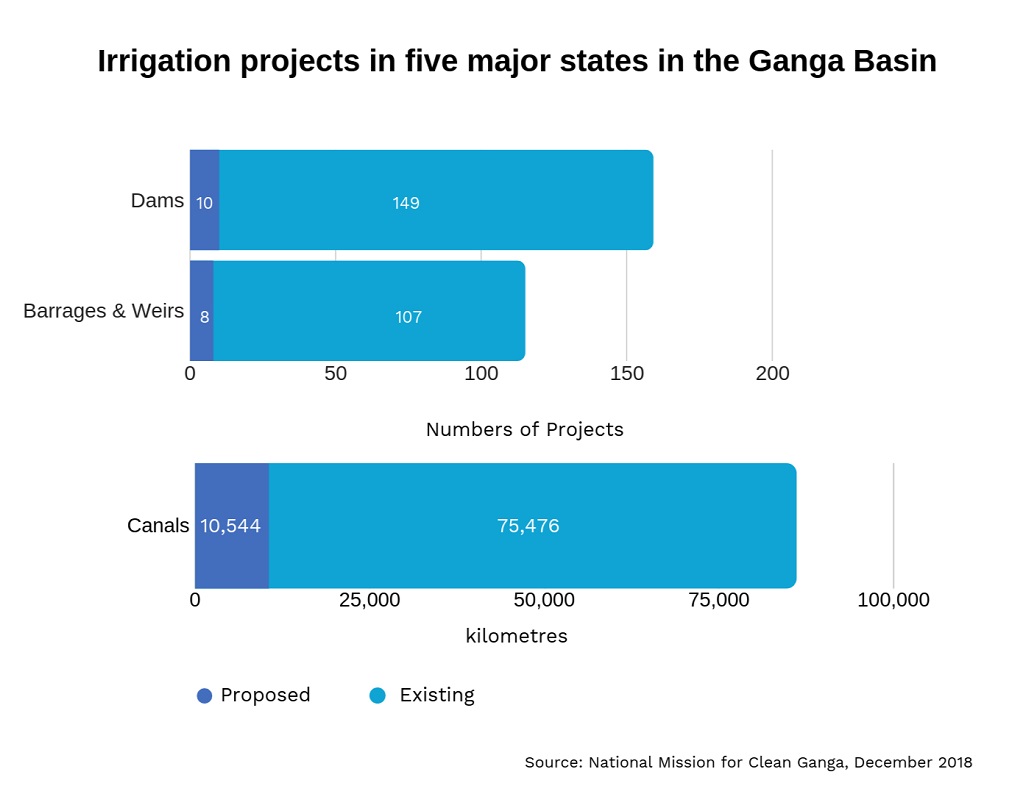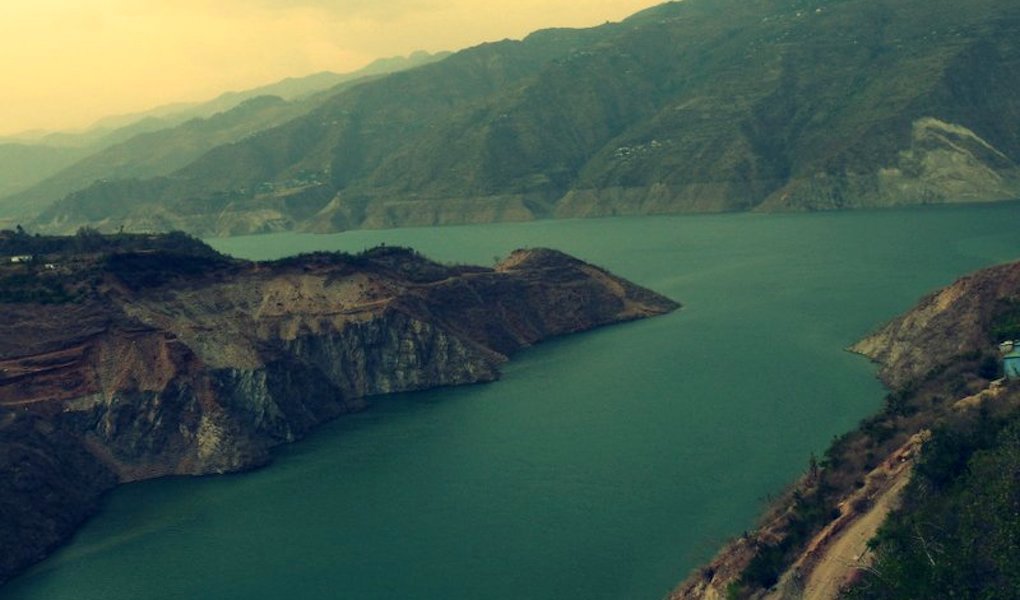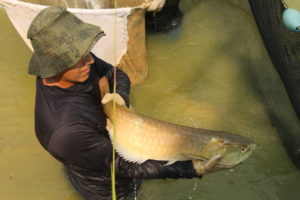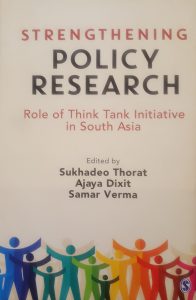For Hariram Shekhawat from the desert city of Jaisalmer in Rajasthan, any body of water bigger than a pond looks like a marvel. A first time visitor to the Kumbh Mela at Allahabad (recently renamed Prayagraj) — the bathing festival of Hindus that is known as the largest public gathering on the planet — Shekhawat was overwhelmed at the confluence of the Ganga and Yamuna.
“So much water,” the pilgrim exclaimed. “The holy Ganga is alive and well.” Not all bathers flocking the confluence to take a dip were as enthusiastic. Some had noticed the sandbars on the Ganga just a few metres upstream. Babulal, who came to the Kumbh from a village not far from Patna, the capital of state of Bihar downstream in the Ganga, was not surprised.
See: A clean Kumbh in a dirty Ganga
“The Ganga near my village also has chars (sandbanks) in the lean season,” said Babulal, who uses one name. Patna is one of the largest cities on the banks of the Ganga in Bihar, and by then the river has been joined by almost all its main tributaries.

Yamuna at the Kumbh Mela in Prayagraj [image by: Soumya Sarkar]
Campaigns for continuous Ganga flow
The reduced flow and declining health of the Ganga has caused much anguish. It is a robust river only during the June-September monsoon rains. There have been strong calls for ensuring aviral dhara (continuous flow) in the river. G.D. Agarwal, the 86-year-old doyen of India’s environmentalists, died in October last year at a Rishikesh hospital after a 111-day fast, demanding action to revive uninterrupted flow in the critically polluted Ganga.
See: Ganga loses its steadfast champion in G.D. Agarwal
Even now in a Rishikesh ashram, a few kilometres upstream of Haridwar where the Ganga reaches the plains from the Himalayas, a 26-year-old Hindu monk Atmabodhanand has been on a hunger strike since October 24, 2018. He has the same demand – let the Ganga flow free.
At 2,525 kilometres, Ganga is the longest river of India, supporting a quarter of India’s 1.3 billion people. Shackled by more than a hundred dams and poisoned by monstrous pollution, the entire river basin has turned sickly in an already water-stressed region.

The main reason for anaemic flow is massive extraction of water for irrigation, said Vinod Tare, river expert and professor at Indian institute of Technology (IIT) Kanpur. This is compounded by to the construction of dams in the upper reaches and reckless groundwater exploitation in the plains. “The reduced flow in the Ganga is not new,” Tare said. “It started during colonial times.”
In 1842, British engineers started building a canal system starting from Bhimgoda barrage in Haridwar. Today the canals irrigate nearly 9,000 square kilometres of farmland in western Uttar Pradesh and Uttarakhand. Tare says that before the Tehri dam was built in 2006, the lean season flow at Haridwar was some 6,500 cusec (cubic foot per second), out of which only about 1,000 cusec was left flowing in the river.
Environmentalists say that no more than 30% of the river’s flow should be diverted for agricultural, domestic or industrial purposes. “A river, to be called a river, must flow. The key issue is dwindling natural flow. If the natural flow is maintained, even pollution can by and large be kept in check through dilution and the river’s ability to self rejuvenate,” said Manoj Mishra, convenor of the Yamuna Jiye Abhiyan (Living Yamuna Campaign).
No stopping diversion
But Tare believes it is now virtually impossible to stop diverting most of the water in the Ganga at Haridwar. “No government can take such a step because it would affect a very large number of farmers in India’s bread basket,” he said. “It’s an impossible decision for any administration.”
The other major problem is the proliferation of a large number of hydropower and irrigation dams built in the headwater tributaries. “In the upper reaches of the Ganga, these dams have caused interruptions in the free flow of the river, affecting the river ecosystem,” says Tare.
Environmentalists have objected strenuously to the building of dams on the headwaters of the Ganga in the Himalayas. Despite nationwide protests, a multi-purpose dam was built on the Bhagirathi River at Tehri in Uttarakhand state in 2006, overriding concerns of building such a massive structure in an ecologically sensitive and earthquake-prone region.

nationwide protests [image by: Lingaraj GJ]
Dams on Ganga River
There is unanimity among experts that no further dams should be built on the Ganga and its tributaries. “Rivers in India need to flow unfettered, period. There should be an absolute ban on building any more dams. Hydropower generation does not require rivers to be dammed,” said Somnath Bandyopadhyay, associate professor at the School of Ecology and Environment Studies in Nalanda University, Bihar. “Even storage of seasonal waters does not require dam construction.”
“There should be an absolute ban on building of any new dam in the country. With hydropower having already become uneconomical non-viable, there is no case for any more such dams anywhere,” said Mishra. “We also need a national policy and action plan on decommissioning of dams, as is happening in many other parts of the world, the US and Europe in particular.”
Bandyopadhyay, who had earlier worked at the National Ganga River Basin Authority, feels that traditional Indian approaches to manage water are more relevant than colonial engineering approaches. “There is a need to increase surface storage. The river need not be dammed for that,” he said. “The floodplains need to be revived.”
The Dehradun-based Wildlife Institute of India said in a 2018 study that 71% of the Bhagirathi River and 48% of the Alaknanda River have been inundated and diverted. As a result, about a third of the river channels have turned into “ecological deserts”, it said.

been interrupted due to the construction of several hydropower dams [image by: Soumya Sarkar]
Overexploited groundwater
The scientific report has also clearly linked the reduced flow to excessive groundwater extraction. The introduction of bore wells – with pumps run by electricity – in the Gangetic plains in the 1970s has led to overexploitation of both shallow and deep aquifers, which has in turn affected the flow in the rivers of the Ganga basin. “During the lean season, groundwater is supposed to partially recharge the river. But due to its over-extraction, the land has become thirsty, which actually soaks water away from the river’s base flow,” said Tare.
Latest research by Hyderabad-based National Geophysical Research Institute shows that the largest depletion of groundwater in the world is taking place in northern India. The government research facility studied fluctuation levels between 2002 and 2017. NITI Aayog, the government’s own think tank, last year released a composite water management index, which showed that 600 million people in India face extreme water stress. Groundwater levels are fast depleting in the states through which the Ganga and its tributaries flow.
“Groundwater recharge on an annual basis is one of the key functions of a free flowing river. There is an urgent need for strict regulation on deep bore extraction anywhere within a river’s flood plain. Dug wells that subsist on shallow aquifers are okay, but tube wells are not,” said Mishra. “We shall have to review the entire practice of river floodplain farming in the country.”
Reviving the flow of Ganga River – an uphill battle
The upshot of all this diversion and extraction of water has resulted in the interrupted flow in the Ganga. One of the key aims of the National Mission to Clean Ganga (NMCG) through the Namami Gange programme launched by Prime Minister Narendra Modi after he was elected to Parliament from Varanasi in 2014 is ensuring aviral dhara (incessant flow), but this is extremely difficult to achieve.
River expert Himanshu Thakkar, coordinator of the South Asia Network on Dams, Rivers and People is critical of Namami Gange. There is “no roadmap” for reviving the Ganga flow, he said. Almost all of the programme funding is directed at cleaning the river basin, mainly through sewer lines and treatment plants, and not much thought has been given to the free flow of the river.
Thakkar’s contention is borne out by the fund allocations in the Namami Gange programme. More than 80% of the money to be spent by the end of 2019 is earmarked for building sewage infrastructure. The allotment for afforestation, which is necessary to boost moisture retention in catchment areas, is a minuscule INR 2.4 billion (USD 33.35 million) compared with INR 247 billion (USD 3.5 billion) for sewage infrastructure.
The focus of central government spending on reviving the Ganga river basin remains overwhelmingly on sewage treatment plants (Source: National Mission for Clean Ganga, December 2018)
The programme also fails to address other threats to the river upstream. Uttarakhand, where the headwaters of the Ganga and Yamuna are located, has seen massive development in recent decades. Although official figures claim an increase in forest cover, environmentalists place a large part of the blame for the devastating 2013 floods due to unplanned development that destabilised slopes. Even now, the government is widening mountain roads that lead to the Char Dham shrines that experts say is harmful to the fragile ecosystem, besides clogging rivers through the dumping of debris.
See: Highway project poses grave danger to Himalayas
Inadequate environmental flow standards
The government in October 2018 set the minimum environmental flows for the Ganga at various locations. This is supposed to be a flow regime that mimics the natural pattern. Scientists and experts, however, argue the standards are insufficient to achieve free flow and will do nothing to ensure aquatic life thrives in the river.
Tare, who has been studying environmental flows in the Ganga basin for many years, is unhappy with the minimum standards. “I don’t know how they arrived at the minimum requirement of 25-30% of lean season flow as sufficient in the upper reaches. These percentage are too low for any revival of the river ecosystem.”
To keep flows in headwater streams healthy, there is no alternative but to develop the watersheds. For this, a bottom-up approach is likely to yield the best results. “Community led groups must be facilitated to re-vegetate catchments, aiming at rejuvenation of local springs and streams,” said Mishra.
“Lack of flow in our rivers is the key issue, and unless that is addressed upfront, all other efforts in its absence (such as pollution control) are destined to fail,” said Mishra. However, a coordinated approach is difficult to achieve, said Bandyopadhyay. “We must recognise that it’s a gigantic and complex problem. Also, rivers are state subjects (under the Indian Constitution) and [the states] have full powers over the quantity of waters to be extracted.”
Unless the central government gets the state administration on board, just pouring money into the Ganga river basin is unlikely to yield results, as is evident from the failed efforts that started in the 1980s. Officials also have to recognise that the water-intensive agriculture practised in the northern plains is unsustainable, experts say.
There is little hope to rejuvenate the Ganga unless there is more awareness of the complex problems, said Tare. Also, there will be no long-term solution if all efforts are paid for by the government. At some point, people have to pay more for ecosystem services, he feels.
This would essentially mean people living in the river basin have to pay for using its waters for various purposes such as drinking, irrigation or industrial use. “Payments for ecosystem services is the most potent tool,” said Bandyopadhyay. “Maintenance and augmentation of the natural capital needs to be paid for by those who benefit to those who maintain and augment.”
![<p>A group of women praying at the confluence of the Ganga and Yamuna in Prayagrajduring the Kumbh Mela. Hindus consider the Ganga holy, and say it is inextricably linked withIndia’s civilizational values [image by: Soumya Sarkar]</p>](https://dialogue.earth/content/uploads/2019/03/Ganga2a.jpg)




![A wild Bengal tiger in Bandhavgarh National Park in Madhya Pradesh [Image by: Mark Smith/Alamy]](https://dialogue.earth/content/uploads/2015/01/wild-tiger-300x200.jpg)
![Jagdishpur lake in Nepal, full of birds [image by: Manoj Paudel]](https://dialogue.earth/content/uploads/2019/03/Birds_Manoj-Paudel_17-300x142.jpg)


